Coronavirus Today: Distance learning gets a downgrade
Good evening. I’m Karen Kaplan, and it’s Tuesday, Sept. 28. Here’s the latest on what’s happening with the coronavirus in California and beyond.
Even with its massive COVID-19 testing program and vaccination mandates for teachers and age-eligible students, the Los Angeles Unified School District can’t make campuses safe for all of its high-risk students.
Alison Goldberg is the mother of 7-year-old twins, one of whom has a metabolic disorder. Her doctor has advised Goldberg to keep the girl at home because her medical condition makes her particularly vulnerable to the coronavirus. So her daughters are spending another year in distance-learning mode.
In the past, that meant relying on Zoom to create a virtual classroom. It wasn’t ideal, but seen through the retrospectoscope, it was an educational paradise.
This year, the twins enrolled in the City of Angeles program and went without a teacher for nearly two weeks. By the time they had a month of online school under their belts, they’d been reassigned teachers three times.
“It’s just a nightmare,” Goldberg said. “Kids like mine are not getting a fair public education.”
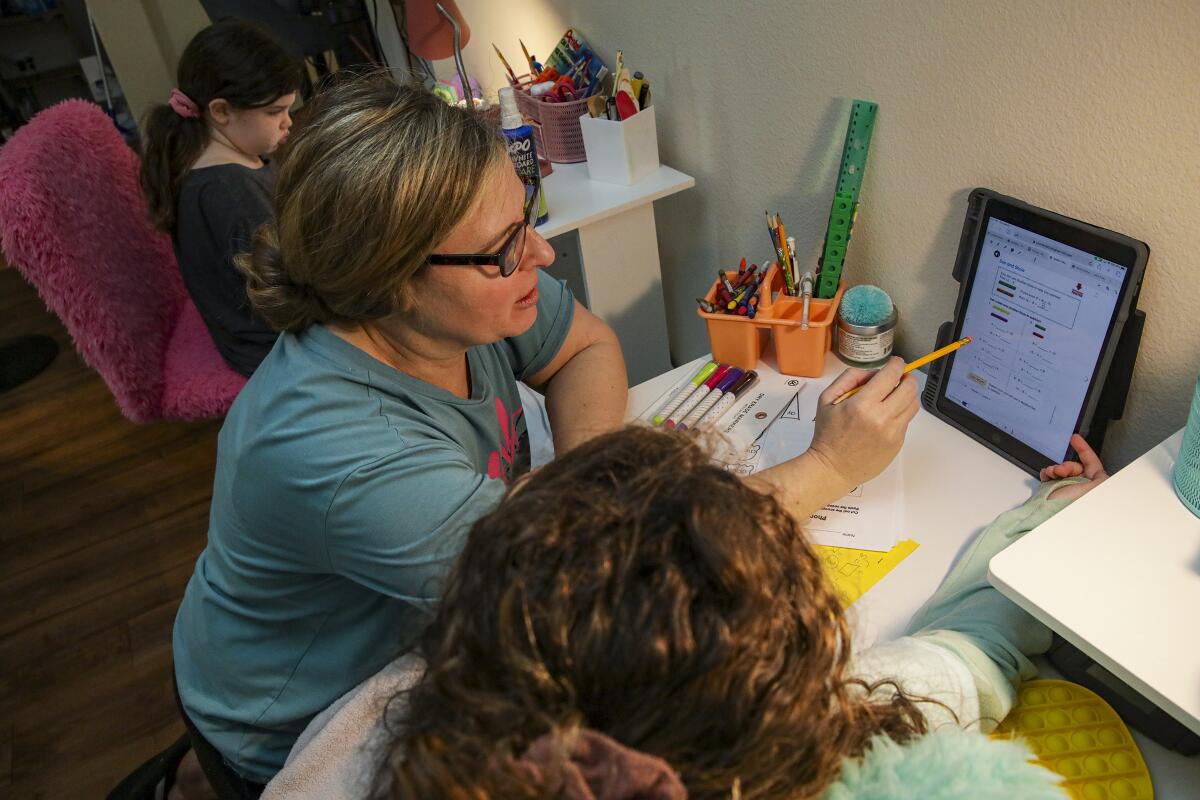
Only about 3% of students in L.A. Unified opted for City of Angels. But in the nation’s second-largest school district, that works out to about 15,000 students. Many of those students were last-minute enrollees, making an already challenging situation worse.
The result has been a string of teacher shortages, administrative errors and enrollment delays. Some kids started school weeks late, and in some cases, their parents are worried that they’ll never catch up.
It hasn’t been smooth sailing for teachers, either. One instructor told my colleagues Howard Blume and Melissa Gomez that she didn’t receive course materials from the district until several weeks into the school year.
City of Angeles used to be an independent study program for students — such as child actors — whose schedules weren’t conducive to normal school hours or who had other unusual needs. They’d complete assignments largely on their own and turn them in to a teacher once a week.
California’s priority for the 2021-22 school year was getting as many students back on campus as possible. Since restoring in-person learning was Job One, running a backup Zoom school wasn’t on the agenda. As a result, independent study programs became the only authorized alternative for those who wouldn’t or couldn’t return to regular classrooms.
School districts around the state soon realized that those programs would have to adapt to their new circumstances. State officials required schools to offer some real-time online interaction with teachers every day. It’s an improvement for students like Goldberg’s twins, but far less than what they’d been used to.
Many new students in middle and high schools expected to have a different teacher for each subject, just as they did in the previous incarnation of remote learning. But that’s not how the independent study program works.
Also missing are speech therapy and other services that parents of students with disabilities had figured they’d be able to access online, or perhaps in-person if necessary. Neither of those options is guaranteed.
Jocelyn Minton has learned the hard way that distance learning isn’t what it used to be. For the first two weeks of the school year, her 5-year-old son logged into his online classroom every day and saw fellow students but no teacher.
She said she’s grateful to have the option to keep her son at home, and despite the rocky start, he’s now reading and doing math assignments with his virtual classmates. Still, as with everything else in the pandemic, there are trade-offs.
“I felt like all of us who chose this safer option had to sacrifice education for health,” Minton said.
By the numbers
California cases and deaths:

Track California’s coronavirus spread and vaccination efforts — including the latest numbers and how they break down — with our graphics.
How the pandemic created more million-dollar homes
We never seem to run out of ways the pandemic has exposed — or deepened — the gap between the haves and the have-nots. The latest example: Million-dollar homes have become the norm in a growing number of Southern California neighborhoods.
As of July, Los Angeles and Orange counties were home to 55 cities and unincorporated areas where the “typical” single-family home is worth at least $1 million. That might not seem remarkable in an area long known for pricey real estate. But what is remarkable is that 17 of those areas joined the list since the start of the pandemic.
Among them are Burbank, Fountain Valley and Torrance, my colleagues Andrew Khouri and Jack Flemming report. The list also includes 15 Los Angeles neighborhoods, including Leimert Park, Woodland Hills, Porter Ranch and Highland Park.
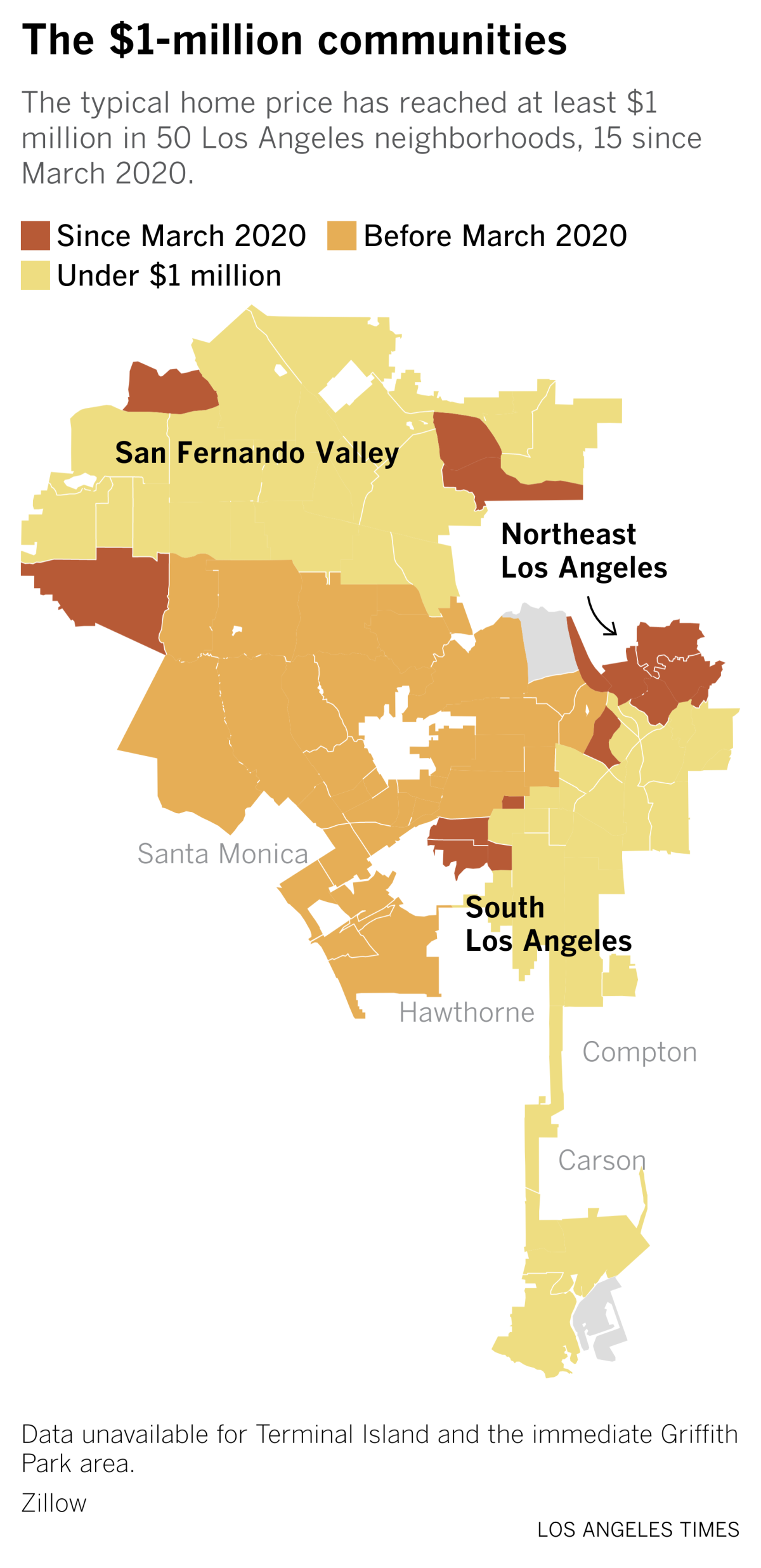
The proliferation of million-dollar homes can be traced to multiple factors, including a surging stock market and the onslaught of millennials looking to become first-time home buyers. There’s also the fact that while millions of Southern Californians have struggled to make ends meet during the pandemic — often risking their health to do so — high-earning professionals were able to save more as their incomes rose while their expenses fell.
The coronavirus lockdowns made our homes a much bigger part of our lives. Those who could afford to get out of cramped apartments were eager to do so — so eager that bidding wars reached new heights. In the first 7½ months of the year, 10% of homes purchased in L.A. County sold for $100,000 or more above the asking price. Only 2% of homes fetched a premium like that during the same period in 2019, according to data from Redfin.
Buyers can afford to bid more because historically low interest rates — a response to the economic devastation wrought by the pandemic — have made borrowing cheap.
Consider a buyer who can swing a 20% down payment on a $1-million home. Fifteen years ago, when the average mortgage rate was 6.47%, this buyer would be looking at a monthly payment of $6,266 (including property tax and insurance). Even three years ago, when the mortgage rate was 4.54%, the monthly payment would have been $5,298.
Earlier this month, the average mortgage rate was only 2.88%. At that rate, the monthly payment would be just $4,546 — a savings of $1,720.
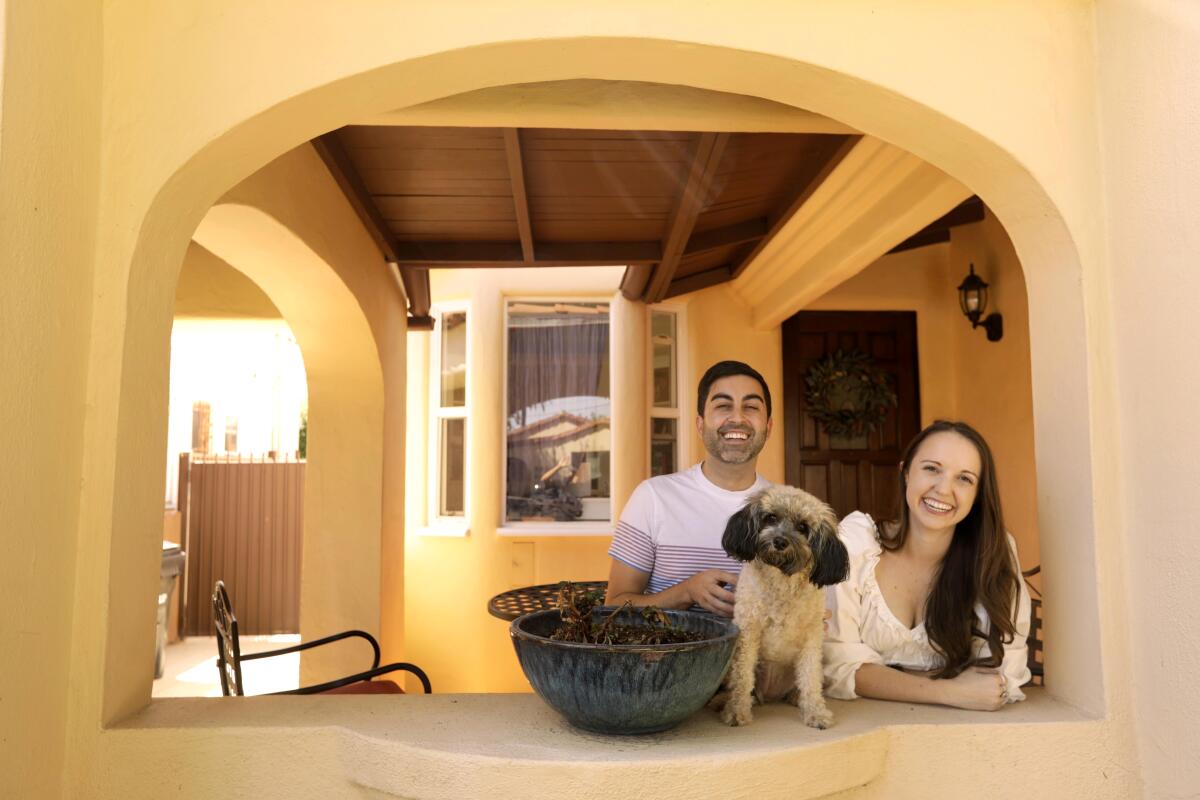
Those kinds of economics are great for people like Devin Sunseri, a 35-year-old reality television producer, and Katie Scardino, a 29-year-old manager of an online tutoring company. In April, the couple purchased a two-bedroom home in Leimert Park for $1,050,000.
“It felt like time,” Sunseri said.
The sale price will help other homeowners build equity and wealth, said Gina Fields, a Leimert Park resident and chair of the neighborhood council for the majority Black neighborhood. But it also pushes home ownership further out of reach for low- and middle-income residents.
If the trends continue, Black Americans risk losing their majority in a place that’s the cultural heart of their community. It’s yet another racial disparity made plain by the pandemic.
“The problem isn’t the housing price,” Fields said. “The problem is more the systemic racism that we face.”
California’s vaccination progress
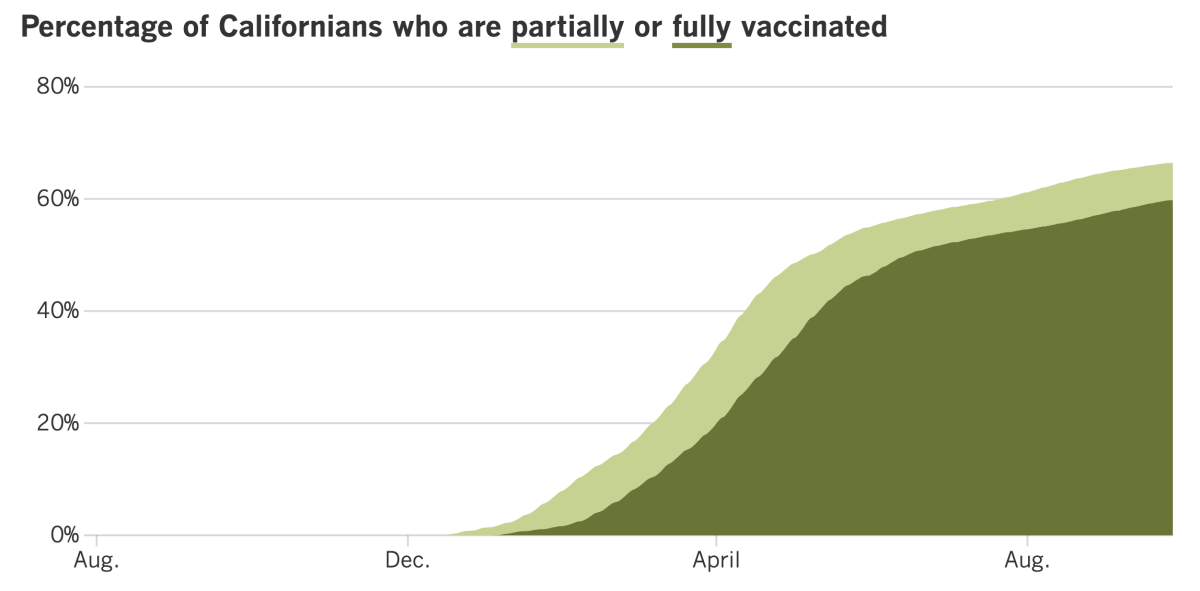
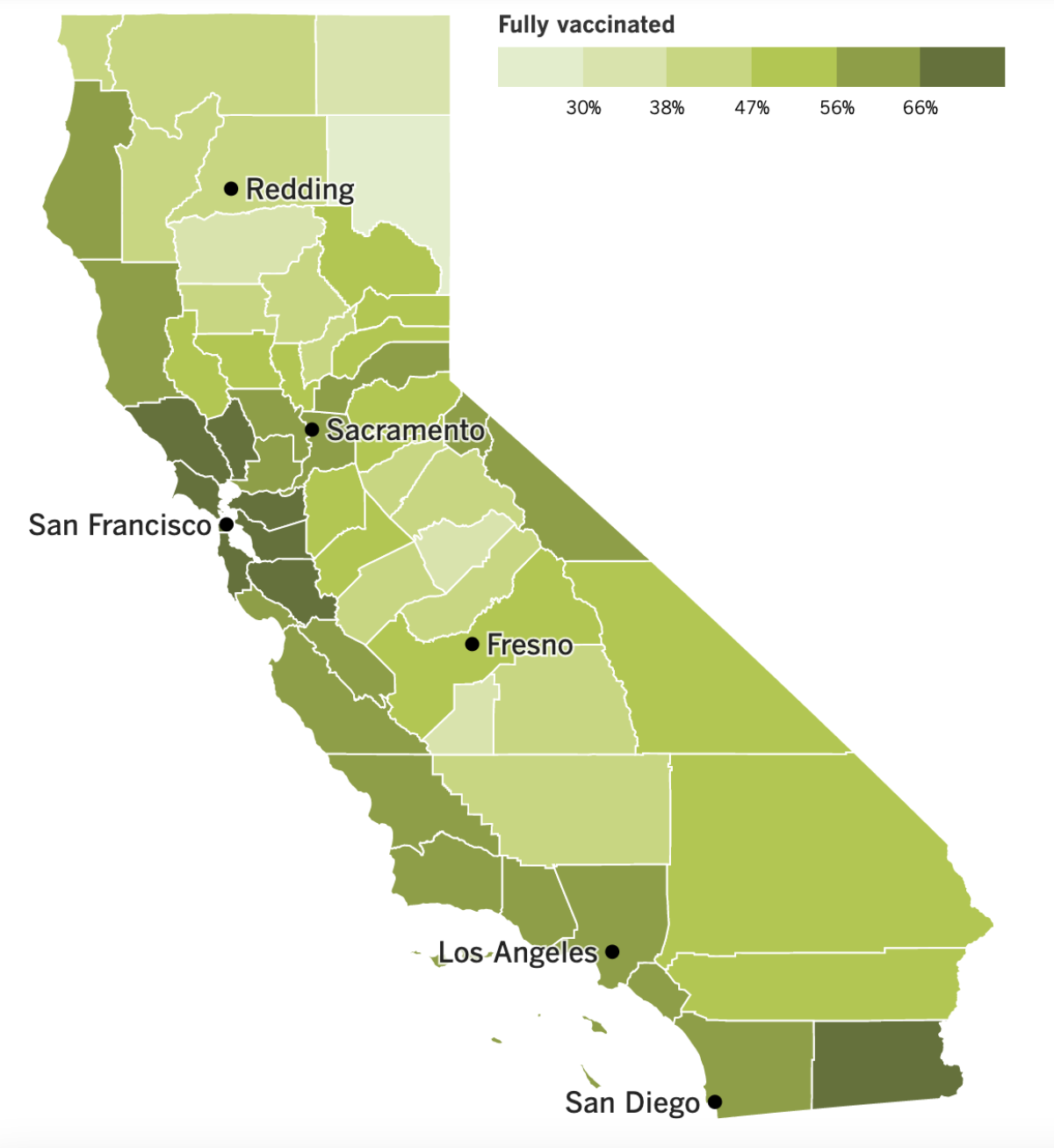
See the latest on California’s vaccination progress with our tracker.
Your support helps us deliver the news that matters most.
In other news ...
No shirt, no shoes, no proof of COVID-19 vaccination — no service. That may become the law in Los Angeles if the City Council votes in favor of it at Wednesday’s meeting.
The proposal would apply to adult customers of a wide range of businesses, including shopping centers, movie theaters, indoor restaurants and coffee shops, gyms, salons, bowling alleys and more. Patrons without proof of vaccination would be able enter a business to use a restroom or pick up a takeout order, but other than that they’d be confined to the outdoor area.
People who can’t get the shots for legitimate medical reasons would be exempted from the mandate, as would those with a written note attesting that they can’t be vaccinated due to a sincerely held religious belief. They would need to produce a recent negative coronavirus test result instead.
In some ways, the Los Angeles proposal is more permissive than orders in San Francisco and Berkeley, which don’t consider a negative test result to be an adequate substitute for the vaccine. On the other hand, L.A.‘s law would cover a wider range of businesses. If it passes, it will take effect Nov. 4.
Speaking of strong vaccine mandates, a federal judge has ordered all correctional officers and other staff at California’s prisons to be vaccinated if they want to keep showing up for work. Exemptions for medical or religious reasons will not be allowed, the judge ruled Monday.
Gov. Gavin Newsom had joined the prison guards union in an effort to block the mandate, which applies to all 34 state prisons. But U.S. District Judge Jon Tigar said there was no other way to prevent a deadly outbreak like the one last summer that killed 28 inmates and one officer at San Quentin. The threat isn’t over — 11 prison staffers have died of COVID-19 since August, the judge noted.
“All agree that a mandatory staff vaccination policy would lower the risk of preventable death and serious medical consequences among incarcerated persons,” Tigar wrote in an order explaining his reasoning. “And no one has identified any remedy that will produce anything close to the same benefit” as a vaccine mandate.
Mandates are also on the table for staff and eligible students of the San Diego Unified School District and elsewhere. The more, the better, argues Business columnist Michael Hiltzik, because vaccine mandates work.
The media and others pay a lot of attention to people who resist the mandates with dramatic vows of mass resignations. In reality, those threats are rarely carried out. More common are experiences like those of United Airlines, which set an Oct. 25 deadline for its 67,000 U.S. employees to get vaccinated. More than 97% have complied.
“The bottom line is that the mandates may have provoked a few hundred workers to resign in protest here or there — but they’ve also prompted thousands to get their shots against COVID-19,” Hiltzik writes.
Here’s some encouraging news for parents who are eager to vaccinate their young children: Pfizer said Tuesday it has turned in results from the clinical study of its vaccine for kids ages 5 to 11.
The data on a lower-dose formulation for that age group were submitted to the U.S. Food and Drug Administration. Last week, the company said the reduced dose produced levels of coronavirus-fighting antibodies that were comparable to those seen in adolescents and adults who got the full-strength vaccine.
Pfizer and BioNTech still have to file an application with the FDA to authorize the pediatric version of its vaccine for emergency use; the companies previously said that filing would be made in the coming weeks. Assuming all goes well, the shots could be available around Thanksgiving or possibly earlier in November, an unnamed source told the Associated Press.
On to booster shots: The Biden administration said Tuesday that more than 400,000 people in the U.S. have received a third dose of the Pfizer-BioNTech COVID-19 vaccine since the supplementary shots were cleared for use last week.
Boosters are now available to certain categories of people who got their second dose of the Pfizer vaccine at least six months ago. Those categories include senior citizens, people with chronic health conditions that make them more vulnerable to a serious case of COVID-19, residents of nursing homes and other group care facilities and people whose jobs put them at higher risk of contracting the virus.
Nearly 1 million Americans have scheduled appointments to get a booster shot, according to Jeff Zients, a White House COVID-19 response coordinator. Advance planning with states, long-term care facilities, doctors and pharmacies enabled the administration to roll out boosters “immediately,” he said.
President Biden, who qualifies for a booster because he is 78, rolled up his left sleeve at the White House on Monday.
“Now, I know it doesn’t look like it, but I am over 65. And that’s why I am getting my booster shot today,” he said as he answered questions from reporters, not even pausing as the needle went into his upper arm.
Finally, I have a request to pass along from my colleague (and past newsletter writer) Deborah Netburn. She’s working on a story about people who struggled with whether they should get vaccinated because of their faith.
“If the decision to get a vaccine (or not) was immediately clear to you, then you are not the right person for this story,” she explains. “But if your decision involved an internal dialogue between your respect for public health and your religious beliefs, then I‘d love to learn more. Please email me at [email protected].”
Your questions answered
Today’s question comes from readers who want to know: How can I get a COVID-19 booster shot?
For starters, you’ll have to meet the current criteria for eligibility. That means you must be fully vaccinated with the Pfizer-BioNTech vaccine, and your second dose was administered at least six months ago.
On top of that, you need to fall into at least one of these four categories:
- People who are 65 and older
- Residents of a long-term care facility
- Those ages 18 to 64 who are at high risk of severe COVID-19
- Members of that same age group who are frequently exposed to COVID-19 because of work or other obligations.
California residents who qualify for a booster can visit the My Turn website to make an appointment for a third dose or look for a walk-in clinic that offers booster doses.
Vaccination sites in L.A. County can also be found on the Department of Public Health’s website. Be sure to set your search criteria to limit the results to locations that offer the Pfizer vaccine.
You’ll need to bring your white CDC vaccination card or a digital record of your vaccination status showing that you were immunized with the Pfizer shot and that it’s not too soon to get a third dose.
Booster doses are not currently available for people who received the Moderna or Johnson & Johnson vaccines.
We want to hear from you. Email us your coronavirus questions, and we’ll do our best to answer them. Wondering if your question’s already been answered? Check out our archive here.
Resources
Need a vaccine? Keep in mind that supplies are limited, and getting one can be a challenge. Sign up for email updates, check your eligibility and, if you’re eligible, make an appointment where you live: City of Los Angeles | Los Angeles County | Kern County | Orange County | Riverside County | San Bernardino County | San Diego County | San Luis Obispo County | Santa Barbara County | Ventura County
Practice social distancing using these tips, and wear a mask or two.
Watch for symptoms such as fever, cough, shortness of breath, chills, shaking with chills, muscle pain, headache, sore throat and loss of taste or smell. Here’s what to look for and when.
Need to get tested? Here’s where you can in L.A. County and around California.
Americans are hurting in many ways. We have advice for helping kids cope, resources for people experiencing domestic abuse and a newsletter to help you make ends meet.
We’ve answered hundreds of readers’ questions. Explore them in our archive here.
For our most up-to-date coverage, visit our homepage and our Health section, get our breaking news alerts, and follow us on Twitter and Instagram.




